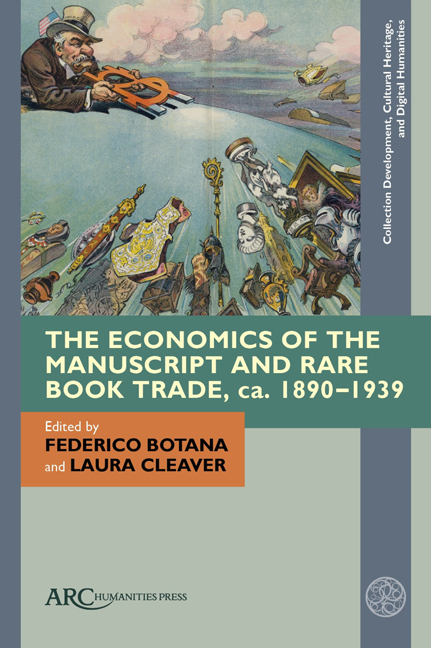Book contents
- Frontmatter
- Contents
- List of Illustrations
- List of Tables
- Acknowledgments
- Abbreviations
- Introduction. The Value of Rare Books
- Chapter 1 Valuing Rare Books in 1920s Germany: Prices in Jacques Rosenthal’s Bibliotheca medii aevi manuscripta
- Chapter 2 Leo S. Olschki’s Card Index and Potential Profits
- Chapter 3 Stock-books and Ledgers: J. & J. Leighton and Édouard Rahir and Company ca. 1897–1904 and E. P. Goldschmidt and Company ca. 1925–1933
- Chapter 4 Léopold Delisle, Henri Omont, and the Price of National Collecting: The Medieval Manuscript Acquisitions of the Bibliothèque nationale ca. 1900–1910
- Chapter 5 Herschel V. Jones: Public Collections and Private Investments
- Conclusion
- Appendix 1 Inflation
- Appendix 2 Exchange Rates
Introduction. The Value of Rare Books
Published online by Cambridge University Press: 28 March 2024
- Frontmatter
- Contents
- List of Illustrations
- List of Tables
- Acknowledgments
- Abbreviations
- Introduction. The Value of Rare Books
- Chapter 1 Valuing Rare Books in 1920s Germany: Prices in Jacques Rosenthal’s Bibliotheca medii aevi manuscripta
- Chapter 2 Leo S. Olschki’s Card Index and Potential Profits
- Chapter 3 Stock-books and Ledgers: J. & J. Leighton and Édouard Rahir and Company ca. 1897–1904 and E. P. Goldschmidt and Company ca. 1925–1933
- Chapter 4 Léopold Delisle, Henri Omont, and the Price of National Collecting: The Medieval Manuscript Acquisitions of the Bibliothèque nationale ca. 1900–1910
- Chapter 5 Herschel V. Jones: Public Collections and Private Investments
- Conclusion
- Appendix 1 Inflation
- Appendix 2 Exchange Rates
Summary
A MARKET FOR rare or unique objects desired by a relatively small group of individuals, whether buying for themselves or for institutions, can be difficult to predict. Rare, or antiquarian, books fall into this category. Auction estimates for such material have always been unreliable, and reserve prices prevent items from being sold for sums deemed too low. Similarly, books may remain in a dealer’s stock for many years before a buyer is found. What appeals to a consumer, and how much they are willing to pay for it, is influenced by many factors and these change over time. When a group of consumers desire the same things, these become fashionable and prices can soar. In the late nineteenth and early twentieth centuries rare books were popular collectors’ items. By the end of the nineteenth century auction houses held sales dedicated to books, and booksellers specializing in rare books were established throughout Europe and on the East coast of the United States. Book auctions were regularly discussed in newspapers and high prices made headlines. “Rare books” was (and is) a broad category, encompassing approximately 1,500 years of written and printed works from around the world. Books that sold for large sums might be valued for their textual content, age, decoration, place of origin, or association with a previous owner. Bookselling has therefore been seen as “different from all other forms of retailing,” both because of the nature of its merchandise and because of the special trading conditions sometimes applied to it. For example, throughout the period of this study books older than twenty years were exempt from import duty in the US. However, the peculiarities of this market are important because the fates of the rare books that were bought and sold in the late nineteenth and early twentieth centuries have played a significant part in shaping the research collections we use today.
In the late nineteenth century a desire to better understand the market for books prompted the publication and study of prices, both for the trade and as a subject of interest in its own right. From 1887 auction prices in Britain were published as Book-Prices Current, the preface to the second volume declaring:
It is only from a careful comparison of the prices realized at auction that the value of a given book can be estimated with any degree of certainty.
- Type
- Chapter
- Information
- Publisher: Amsterdam University PressPrint publication year: 2024



